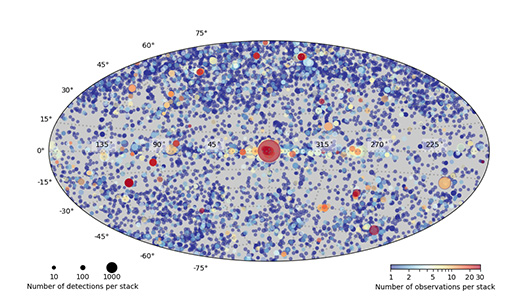New Version of Chandra Source Catalog Released
The Chandra Source Catalog (CSC) is the definitive catalog of X-ray sources detected by the observatory. The latest version, known as CSC 2.1, was released in early April 2024.
Since the Uhuru satellite in the 1970s, X-ray astrophysics missions have a tradition of publishing detailed catalogs of the X-ray sources detected along with a list of key physical properties.
CSC 2.1. carries this tradition forward. Below is an adapted announcement from members of the team who worked on this important resource for the scientific community:
The Chandra X-ray Center (CXC) is pleased to announce the availability of Release 2.1 of the Chandra Source Catalog (CSC 2.1). This catalog covers roughly 730 square degrees of sky and contains 407,806 unique X-ray sources and over 1.3 million individual source detections identified in more than 15,000 Chandra imaging observations released publicly prior to the end of 2021.
Chandra and Voyager: A Robust 3D Experience

A screenshot from the Smithsonian Voyager 3D platform: Vela Pulsar is shown here with its ejecta and blast wave turned on. Explore the Vela sonification and visual description tour while tumbling around the 3D model and turning the ejecta and blast wave on and off. Download an stl model for 3D printing to hold the Vela Pulsar in your hand.
Credit: INAF-Observatorio Astronomico di Palermo/S.Orlando & NASA/CXC/SAO/A. Jubett et al; Smithsonian Institution/J. Cope, M. Dattoria et al;
The creative team at Chandra X-ray Center has been hard at work on a collaboration with the Smithsonian Institution’s Digitization Program Office (3D SI). Together, our teams have been bringing three-dimensional X-ray datasets to the Voyager platform to offer inclusive, multi-sensory learning experiences.
The Chandra X-ray Observatory is one of NASA's “Great Observatories” (along with the Hubble Space Telescope and the James Webb Telescope). Chandra, the world's most powerful X-ray telescope, is still going strong after 25 years in orbit. The Smithsonian Astrophysical Observatory (SAO) in Massachusetts operates the telescope and runs the science center on behalf of NASA.
In 2021, Chandra and 3D SI released a collection of cosmic models showing various high-energy phenomena in three dimensions including novas, supernovas, pulsars, and the Chandra telescope itself. These 3D representations provided the opportunity for users to tumble around each object and learn about its features and the science behind the model. This has been a huge step in granting greater access to these incredible 3D models and prints for institutions like libraries and museums, as well as the scientific community and individuals in the greater public.
Scientists from Brown, NASA and the Smithsonian Bring Cosmic Explorations to Smartphones
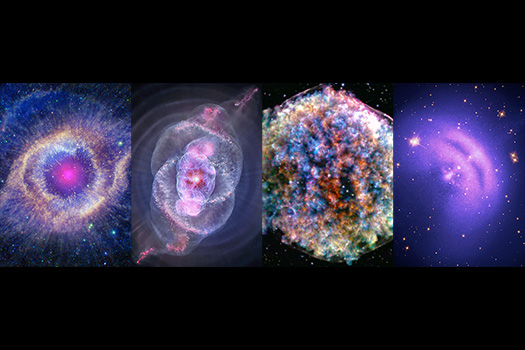
A set of new augmented reality (AR) experiences lets users
travel virtually through cosmic objects in 3D.
The following press release from Brown University, being released in conjunction with another from the Smithsonian Institution, highlights an exciting new project that brings cosmic objects in 3D to Instagram “experiences.” This project was led by Dr. Kimberly Arcand of the Smithsonian Astrophysical Observatory that runs the Chandra X-ray Center on behalf of NASA. These new Chandra Instagram experiences are the first ever to include sonifications (translations of data into sound) and represent a new way of making astronomical data more accessible.
By using a phone camera and a new set of Instagram augmented reality filters, anyone can dive into the depths of space, encountering nebulae, pulsars and even remnants of exploded stars.
Gaze at the ethereal colors of distant nebulae. Zoom in to the heart of an exploded star. Listen to chimes, bells and electric rhythms representing a celestial object far off in space. Through new Instagram filters, users of the app can now embark on cosmic journeys through their smartphones with space-themed augmented reality experiences.
The filters are fun, for sure — but they’re also grounded in some serious science. The experiences were created by researchers from Brown University, Smithsonian Astrophysical Observatory and NASA to celebrate the 25th anniversary the Chandra spacecraft, NASA’s flagship X-ray telescope. The goals are to engage the public, make images of space more accessible and add new layers of understanding to some of the most well-known and widely studied objects in the sky.
Stunning Echo of 800-year-old Explosion
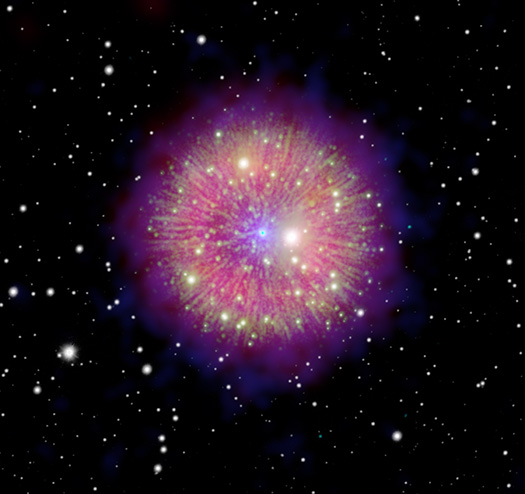
SNR 1181 / Pa 30
Credit: X-ray: (Chandra) NASA/CXC/U. Manitoba/C. Treyturik, (XMM-Newton) ESA/C. Treyturik; Optical: (Pan-STARRS) NOIRLab/MDM/Dartmouth/R. Fesen; Infrared: (WISE) NASA/JPL/Caltech/; Image Processing: Univ. of Manitoba/Gilles Ferrand and Jayanne English
In the year 1181 a rare supernova explosion appeared in the night sky, staying visible for 185 consecutive days. Historical records show that the supernova looked like a temporary ‘star’ in the constellation Cassiopeia shining as bright as Saturn.
Ever since, scientists have tried to find the supernova’s remnant. At first it was thought that this could be the nebula around the pulsar — the dense core of a collapse star — named 3C 58. However closer investigations revealed that the pulsar is older than supernova 1181.
In the last decade, another contender was discovered; Pa 30 is a nearly circular nebula with a central star in the constellation Cassiopeia. It is pictured here combining images from several telescopes. This composite image uses data across the electromagnetic spectrum and shows a spectacular new view of the supernova remnant. This allows us to marvel at the same object that appeared in our ancestors’ night sky more than 800 years ago.
NASA's Chandra Identifies an Underachieving Black Hole

Quasar H1821+643
Credit: X-ray: NASA/CXC/Univ. of Nottingham/H. Russell et al.; Radio: NSF/NRAO/VLA; Image Processing: NASA/CXC/SAO/N. Wolk
This image shows a quasar, a rapidly growing supermassive black hole, which is not achieving what astronomers would expect from it, as reported in our latest press release. Data from NASA’s Chandra X-ray Observatory (blue) and radio data from the NSF’s Karl G. Jansky’s Very Large Array (red) reveal some of the evidence for this quasar’s disappointing impact on its host galaxy.
Known as H1821+643, this quasar is about 3.4 billion light-years from Earth. Quasars are a rare and extreme class of supermassive black holes that are furiously pulling material inwards, producing intense radiation and sometimes powerful jets. H1821+643 is the closest quasar to Earth in a cluster of galaxies.
Quasars are different than other supermassive black holes in the centers of galaxy clusters in that they are pulling in more material at a higher rate. Astronomers have found that non-quasar black holes growing at moderate rates influence their surroundings by preventing the intergalactic hot gas from cooling down too much. This regulates the growth of stars around the black hole.
Celebrate the 25th anniversary of NASA’s Chandra X-ray Observatory with us

Celebrate the 25th anniversary of NASA’s Chandra X-ray Observatory with us
The Chandra X-ray Observatory is unlike any other telescope. Since its launch into space on July 23, 1999, Chandra has been NASA’s flagship mission for X-ray astronomy in the fleet of “Great Observatories.”
Chandra discovers exotic new phenomena and examines old mysteries, looking at objects within our own Solar System out to nearly the edge of the observable Universe.
Chandra makes significant discoveries on its own, but also in concert with other telescopes and instruments in the quest to understand the Universe.
Chandra’s imaging capabilities and observing efficiency still exceed pre-launch requirements after 25 years of operations. The observatory is capable of many more years of operation and scientific discovery. Many current themes in astrophysics, along with new NASA facilities to address these, rely on unique information from Chandra.

Chandra is capable of discoveries that no other telescopes can make.
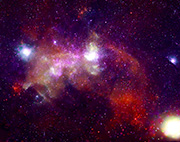
Chandra sees X-rays, a critical and unique window into the hottest and most energetic places in the Universe.

Chandra has sharper X-ray vision than any other X-ray telescope — current or planned for decades to come.
We are on the precipice of so many discoveries. What wonders will come next?
Listen to the Universe: New NASA Sonifications and Documentary
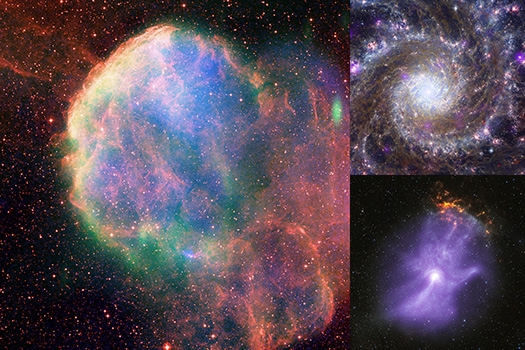
IC 443, M74, and MSH 15-52
Sonification Credit: NASA/CXC/SAO/K.Arcand, SYSTEM Sounds (M. Russo, A. Santaguida)
Three new sonifications of images from NASA’s Chandra X-ray Observatory and other telescopes have been released. This work is also being featured in a new NASA+ documentary, "Listen to the Universe."
Sonification is the process of translating data into sounds. In the case of Chandra and other telescopes, scientific data are collected from space as digital signals that are commonly turned into visual imagery. The sonification project takes these data through another step of mapping the information into sound.
Chandra Ties Powerful Black Hole to Stellar Beads-on-a-String

Osase Omoruyi with her parents’ favorite beads.
We are happy to welcome Osase Omoruyi as a guest blogger. Osase is the first author of the paper that is the focus of our latest press release, and is an NSF Graduate Research Fellow at Harvard University, where she is currently completing her PhD in Astronomy and Master’s in History of Science. Osase uses a variety of telescopes, from X-ray through Radio, as well as computer simulations, to study the fascinating life of galaxies. She is particularly interested in how stars and black holes, which are small in comparison to the scale of a whole galaxy, can transform how galaxies change over time.
In 2008, astronomers using the Wisconsin–Indiana–Yale NOAO (WIYN) telescope in Arizona published images of the newly discovered galaxy cluster named SDSS J1531+3414 (SDSS J1531 for short). At first glance, it seemed like a standard massive cluster of galaxies with one giant galaxy in its center, hundreds of others surrounding it, and arc-like structures caused by gravitational lensing – a phenomenon where the cluster's gravity bends light from galaxies behind it.
However, our understanding of SDSS J1531 changed dramatically in 2014 when the Hubble Space Telescope provided a higher-resolution view of the cluster from space. Contrary to initial beliefs, the heart of the cluster housed not one but two massive galaxies, on course to collide and merge into a single entity. They also featured 19 clusters of young stars wrapped around them in a pattern that resembled beads on a string.
Stellar Beads on a String
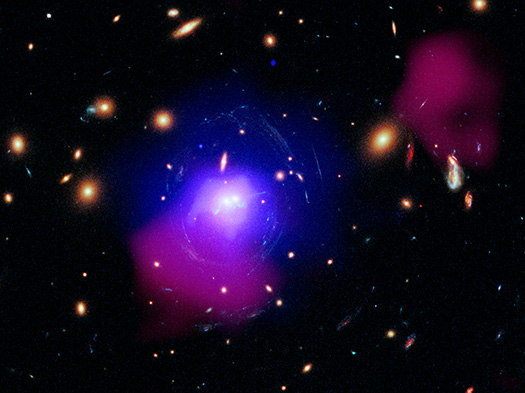
SDSS J1531+3414
Credit: X-ray: NASA/CXC/SAO/O. Omoruyi et al.; Optical: NASA/ESA/STScI/G. Tremblay et al.;
Radio: ASTRON/LOFAR; Image Processing: NASA/CXC/SAO/N. Wolk
Astronomers have discovered one of the most powerful eruptions from a black hole ever recorded in the system known as SDSS J1531+3414 (SDSS J1531 for short). As explained in our press release, this mega-explosion billions of years ago may help explain the formation of a striking pattern of star clusters around two massive galaxies, resembling “beads on a string.”
SDSS J1531 is a massive galaxy cluster containing hundreds of individual galaxies and huge reservoirs of hot gas and dark matter. At the center of SDSS J1531, which is located about 3.8 billion light-years away, two of the cluster’s largest galaxies are colliding with each other.
Astronomers used several telescopes to study SDSS J1531 including NASA’s Chandra X-ray Observatory, and the Low Frequency Array (LOFAR), a radio telescope. This composite image shows SDSS J1531 in X-rays from Chandra (blue and purple) that have been combined with radio data from LOFAR (dark pink) as well as an optical image from the Hubble Space Telescope (appearing as yellow and white). The inset gives a close-in view of the center of SDSS J1531 in optical light, showing the two large galaxies and a set of 19 large clusters of stars, called superclusters, stretching across the middle. The image shows these star clusters are arranged in an ‘S’ formation that resembles beads on a string.
Telescopes Show the Milky Way's Black Hole is Ready for a Kick
This artist’s illustration depicts the findings of a new study about the supermassive black hole at the center of our galaxy called Sagittarius A* (abbreviated as Sgr A*). As reported in our latest press release, this result found that Sgr A* is spinning so quickly that it is warping spacetime — that is, time and the three dimensions of space — so that it can look more like a football.
These results were made with NASA’s Chandra X-ray Observatory and the NSF’s Karl G. Jansky Very Large Array (VLA). A team of researchers applied a new method that uses X-ray and radio data to determine how quickly Sgr A* is spinning based on how material is flowing towards and away from the black hole. They found Sgr A* is spinning with an angular velocity that is about 60% of the maximum possible value, and with an angular momentum of about 90% of the maximum possible value.

